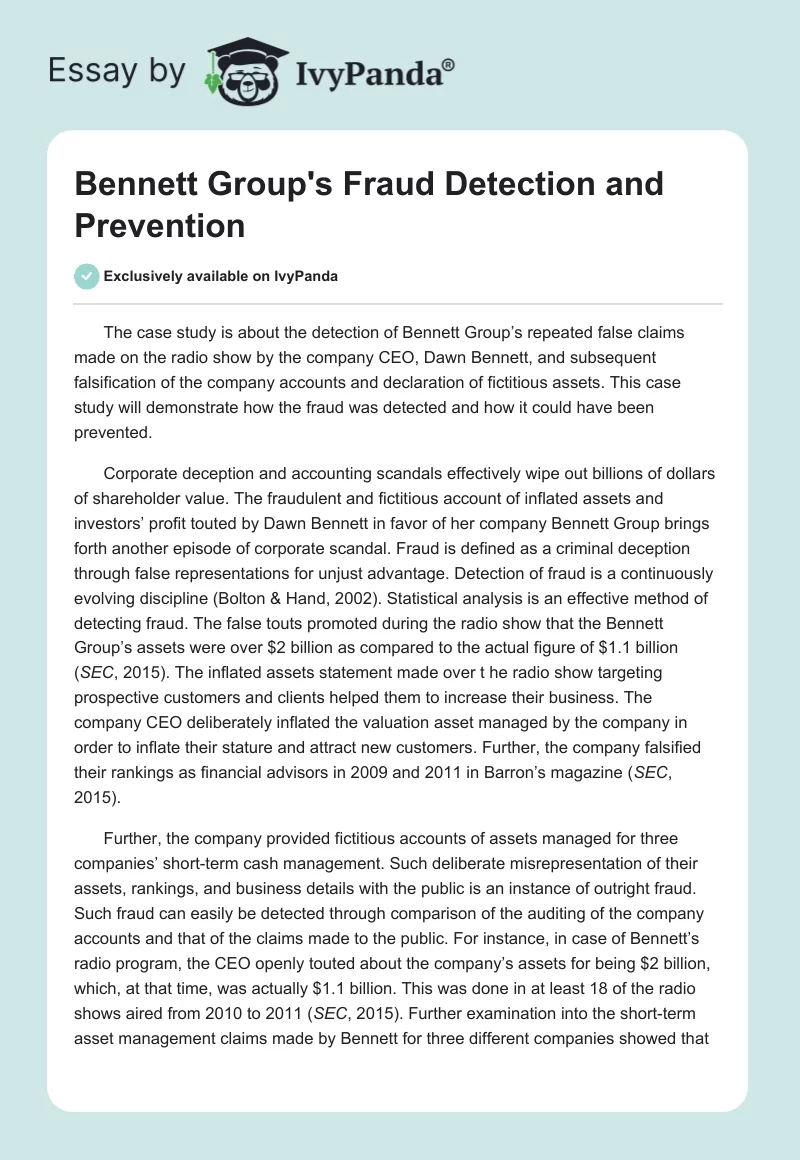The case study is about the detection of Bennett Group’s repeated false claims made on the radio show by the company CEO, Dawn Bennett, and subsequent falsification of the company accounts and declaration of fictitious assets. This case study will demonstrate how the fraud was detected and how it could have been prevented.
Corporate deception and accounting scandals effectively wipe out billions of dollars of shareholder value. The fraudulent and fictitious account of inflated assets and investors’ profit touted by Dawn Bennett in favor of her company Bennett Group brings forth another episode of corporate scandal. Fraud is defined as a criminal deception through false representations for unjust advantage. Detection of fraud is a continuously evolving discipline (Bolton & Hand, 2002). Statistical analysis is an effective method of detecting fraud. The false touts promoted during the radio show that the Bennett Group’s assets were over $2 billion as compared to the actual figure of $1.1 billion (SEC, 2015). The inflated assets statement made over t he radio show targeting prospective customers and clients helped them to increase their business. The company CEO deliberately inflated the valuation asset managed by the company in order to inflate their stature and attract new customers. Further, the company falsified their rankings as financial advisors in 2009 and 2011 in Barron’s magazine (SEC, 2015).
Further, the company provided fictitious accounts of assets managed for three companies’ short-term cash management. Such deliberate misrepresentation of their assets, rankings, and business details with the public is an instance of outright fraud. Such fraud can easily be detected through comparison of the auditing of the company accounts and that of the claims made to the public. For instance, in case of Bennett’s radio program, the CEO openly touted about the company’s assets for being $2 billion, which, at that time, was actually $1.1 billion. This was done in at least 18 of the radio shows aired from 2010 to 2011 (SEC, 2015). Further examination into the short-term asset management claims made by Bennett for three different companies showed that the accounts did match the reality. For instance, the first company for which Bennett claimed to have managed the short-term asset was found to be false.
Bennett served as a financial advisor to the first company’s investment committee from 2006 through 2011 for the retirement plan for its employees. The assets managed by Bennett Group for the first company was not more than $40 million. However, the figure was inflated to $706 million (SEC, 2015). Further discrepancy was also found in the company’s statements about their dealings with the CFO of the first company who had allegedly retired before the period Bennett mentioned she had communicated with him. Such discrepancy instatement also created doubt about the statements made by Bennett in her defense. Similarly, for the second company statements and figures did not match from 1988 through 2012 and for a third company from 2006 through 2009. In each case the assets managed showed on record was much higher than the actual figures.
The fraud can easily detected through auditing of the financial accounts presented by the company. One method that can be employed to detect fraud is to create a suspicion score for the company. Suspicion score can be computed from the database for every company, which would tally the degree of adjustments made in the accounts to create a substantial assets base. As it is extremely expensive to undertake an investigation of all the records, one has to concentrate on one of the areas, which is considered fraudulent by the company. One method can be the linear discriminatory analysis that helps in detecting fraud. Certain if and then based algorithms can be a helpful method to detect fraud and eventually prevent them. Link analysis is used especially for frauds done using the social media. This is a more relevant form that can be used to check the fraud done by Bennett by touting its inflated assets on her radio show. The statistical models of fraud detection can be updated according to the requirements of specific companies.
The prevention of fraud by Bennett group was possible by continuous correspondence at all levels of communication. However, this is a costly and effort-consuming process (Bierstaker, Brody, & Pacini, 2006). Red flagging the areas where accounts do not match official figures or where accounting adjustments have been rampantly employed may lead to auditor’s suspicion and help create a red flag. In such cases, the auditor must inform the company and the company in turn should undergo a thorough check up of the area where the red flag had been put. The primary goals of the company should be to maintain an effective fraud policy in order to provide guidance to the employees the corporate code of conduct. Continuous training and seminars should be held for existing as well as new employees to communicate this policy. Further investigation of the company’s vulnerability to fraud must be done in order to assess the assets of the company and how they can be defrauded (Bierstaker et al. 2006). Further continuous analytical reviews of the company accounts can check propensity to fall susceptible to fraud.
References
Bierstaker, J. L., Brody, R. G., & Pacini, C. (2006). Accountants’ perceptions regarding fraud detection and prevention methods. Managerial Auditing Journal , 21 (5), 520-535.
Bolton, R. J., & Hand, D. J. (2002). Statistical Fraud Detection: A Review. Statistical Science , 17 (3), 235-255.


